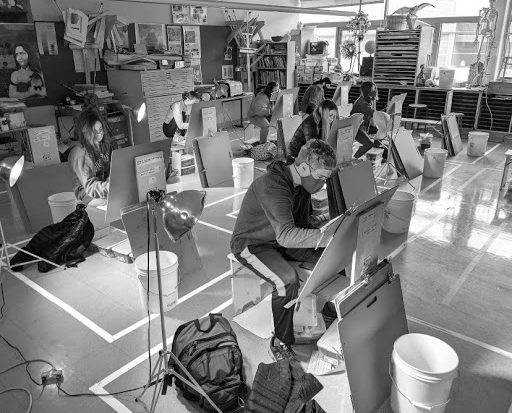Teaching FATA Through the Hybrid Model

The FATA department has adapted to COVID-19 protocols.
This year has brought about change to all of the classes at L-S. Teachers and faculty have to think about changes to the curriculum, being efficient with the shorter timings, class size, spacing, and using technology to make everything possible. There was also a change in the schedule from last year to allow for the transportation between the in-person and remote classes each day, only giving one in-person class day for each cohort for each class. Teachers have had to adapt to using Google Classroom and learning how to use other resources such as Jamboards, EdPuzzle, and Pear Deck. These changes have produced new challenges for every class, but not as much as it has for hands-on classes such as those in the FATA department.
One main issue among most departments, and especially FATA, was how to use their minimal in-person class time to still have students learn the skills they need. Many teachers found it helpful to run a flipped classroom. Tutorial and content videos are made outside of class and posted on Google Classroom so students can watch them and rewatch them on their own while synchronous class time is used for discussions and project work. This has been beneficial in many ways. Posted tutorials allow students who were absent or those who need a refresher easy access instead of spending class time setting everything up or asking students to come outside of class to go over the material. Having class time strictly for project work allows students more opportunities to ask for help on their projects. The lack of time has also caused teachers to minimize the projects done during the semester, forcing them to prioritize projects which allow the students to learn the skills necessary for the course and to be able to apply them.
The question of materials also comes up. Similar to the science kits sent home with each student, FATA students are also given individual kits containing tools they will need to work on projects at home. The materials in class are also separated for safety reasons and each student has their own space and easel depending on the type of class. Ceramics students had different kits than drawing students. However, the types of tools and projects students can do is also limited depending on pricing and accessibility for certain materials.
Mr. Durocher, a new teacher this year at L-S, teaches graphic design, digital photography, and digital imaging classes. He has found that because his classes were already mostly tech-based, the change has been somewhat easier for him. Nevertheless, he has encountered much of the same problems as other teachers. He had to make sure that everyone’s device could support certain applications for his classes, and find ones which would be the best suited for their project work. He has also observed that most of the work for projects has to be done at home because of the shorter classes. Durocher has also observed, as a result of the work done at home, that there is much more variety and creativity amongst the work of the students because each student has observed different things of their surroundings while at home. His students have shown him and demonstrated to him through their work a greater understanding of the content. “This year has been a challenging year for all and there have been a lot of changes, but I have been very impressed with the way my students have adapted to the changes,” says Durocher.
Ms. Peterson has been teaching at LS for many years and this year she is teaching ceramics, drawing, and painting. In her classes she has observed that with the smaller class sizes, it has made it easier for her to talk to each individual student, but at the same time it has been harder to have private conversations. This has also limited peer teaching and feedback, but with the help of group Jamboards, some sense of collaboration has been preserved. Peterson finds that most of her class relies on technology; from access to tutorials to distant live demos, everything requires the knowledge and cooperation of technology. Although at first she encountered some difficulties, she feels that the students have been able to continue their learning through these methods. She says, “I have learnt so much about technology that I can use to better my classes after the pandemic is over.”
Ms. Fine-Wilson is another ceramics teacher, and also teaches AP Art. Having remote students in her classes has allowed her to find ways to livestream the class. She uses two computers, which she shifts between her two classrooms, so that students at home can be a part of the classroom. In her ceramics class, Ms. Fine-Wilson has found that not much work on the ceramics pieces can get done because of the disinfecting procedures and the prolonged clean up due to safety precautions. Students have been working with clay at home and come into class with their pieces to work on or be put in the kiln. She also has many remote students in her AP Art class and it can be challenging to try and pay attention to both the students in the Meet and those in the classroom. She has also found that it can be hard for students at home to see what she is demonstrating in class. The feedback the students give her has helped troubleshoot the problems and give them the best possible. “It certainly has not been the same as being in the studio with everyone,” she says.



